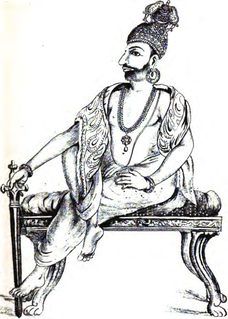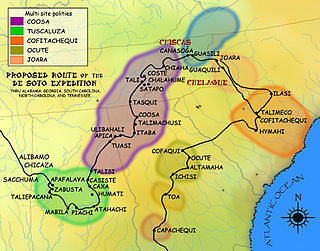This page is based on this
Wikipedia article Text is available under the
CC BY-SA 4.0 license; additional terms may apply.
Images, videos and audio are available under their respective licenses.

Sierra Leone is a country located in West Africa, known officially as the Republic of Sierra Leone.

Gombe, usually referred to as Gombe State to distinguish it from the city of Gombe, is located in the northeastern part of Nigeria, is one of the country's 36 states; its capital is Gombe. The boundaries of the state roughly correspond to those of the Tangale-Waja Chiefdom and Gombe Emirate, a traditional state.

Marthanda Varma, known as the Maker of Modern Travancore, was ruler of the Indian state of Travancore (Venadu) from 1729 until his death in 1758. He was succeeded by Rama Varma (1758–98).

Caborn-Welborn was a prehistoric North American culture defined by archaeologists as a Late Mississippian cultural manifestation that grew out of – or built upon the demise of – the Angel chiefdom located in the territory of southern present-day Indiana. Caborn-Welborn developed around 1400 and seems to have disappeared around 1700. The Caborn-Welborn culture was the last Native American occupation of southern Indiana before European contact. It remains unclear which historic-era native group, if any, are their descendants.
The Mumuyes are a people of Nigeria. They speak the Mumuye language. They constitute the largest tribal group in Taraba State of Nigeria and form the predominant tribes found in Zing, Yorro, Jalingo, Ardo-Kola, Lau, Gassol, Bali and Gashaka, all of which are local government areas of the state. Mumuyes are also widely found in many parts of the neighboring Adamawa State.

The Coosa chiefdom was a powerful Native American paramount chiefdom in what are now Gordon and Murray counties in Georgia, in the United States. It was inhabited from about 1400 until about 1600, and dominated several smaller chiefdoms. The total population of Coosa's area of influence, reaching into present-day Tennessee and Alabama, has been estimated at 50,000.

Aneityum is the southernmost island of Vanuatu, in the province of Tafea.

The Timucuan Ecological and Historic Preserve is a U.S. National Preserve in Jacksonville, Florida. It comprises 46,000 acres (19,000 ha) of wetlands, waterways, and other habitats in northeastern Duval County. Managed by the National Park Service in cooperation with the City of Jacksonville and Florida State Parks, it includes natural and historic areas such as the Fort Caroline National Memorial and the Kingsley Plantation.

Gbarzon District is one of three districts located in Grand Gedeh County, Liberia.
The Kono language (Kɔnɔ) is a language spoken in Sierra Leone by the Kono people. The Kono District is situated in the Eastern Province of Sierra Leone and contains 14 chiefdoms, each headed by a Paramount Chief. The language varies slightly between chiefdoms.

Sigavé is one of the three official chiefdoms of the French territory of Wallis and Futuna in Oceania in the South Pacific Ocean.

Alo is one of three official chiefdoms of the French territory of Wallis and Futuna in Oceania in the South Pacific Ocean.

The chiefdoms of Sierra Leone are the third-level units of administration in Sierra Leone. There are 190 chiefdoms in Sierra Leone, as of 2017. Previously, there were 149.

Liberia is divided into fifteen counties, which, in turn, are subdivided into a total of 90 districts and further subdivided into clans.

The subdivisions of Sierra Leone are as follows:

The Agua Dulce or Agua Fresca (Freshwater) were a Timucua people of northeastern Florida. They lived in the St. Johns River watershed north of Lake George, and spoke a dialect of the Timucua language also known as Agua Dulce.

Chiefdoms and sectors of the Democratic Republic of the Congo are the fourth-level administrative divisions of the Democratic Republic of the Congo.

The Little Egypt site was an archaeological site located in Murray County, Georgia, near the junction of the Coosawattee River and Talking Rock Creek. The site originally had three platform mounds surrounding a plaza and a large village area. It was destroyed during the construction of the Dam of Carters Lake in 1972. It was situated between the Ridge and Valley and Piedmont sections of the state in a flood plain. Using Mississippian culture pottery found at the site archaeologists dated the site to the Middle and Late South Appalachian culture habitation from 1300 to 1600 CE during the Dallas, Lamar, and Mouse Creek phases.
















